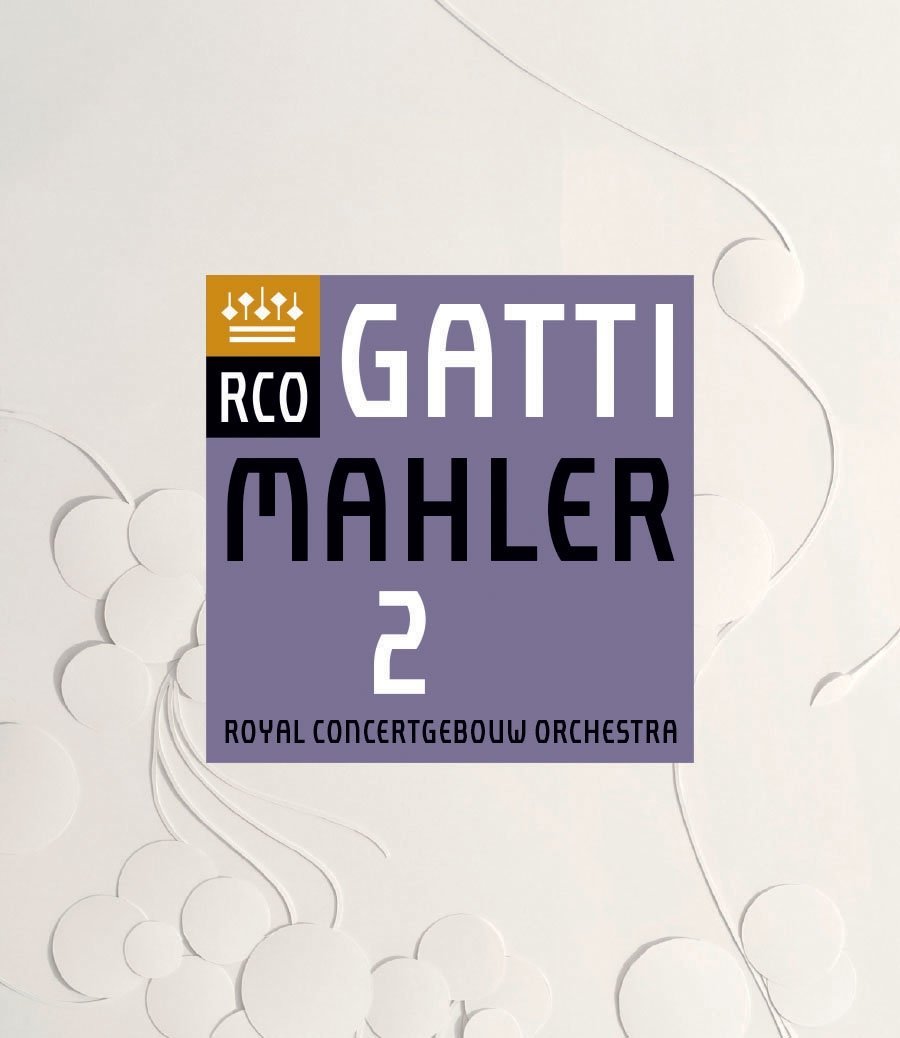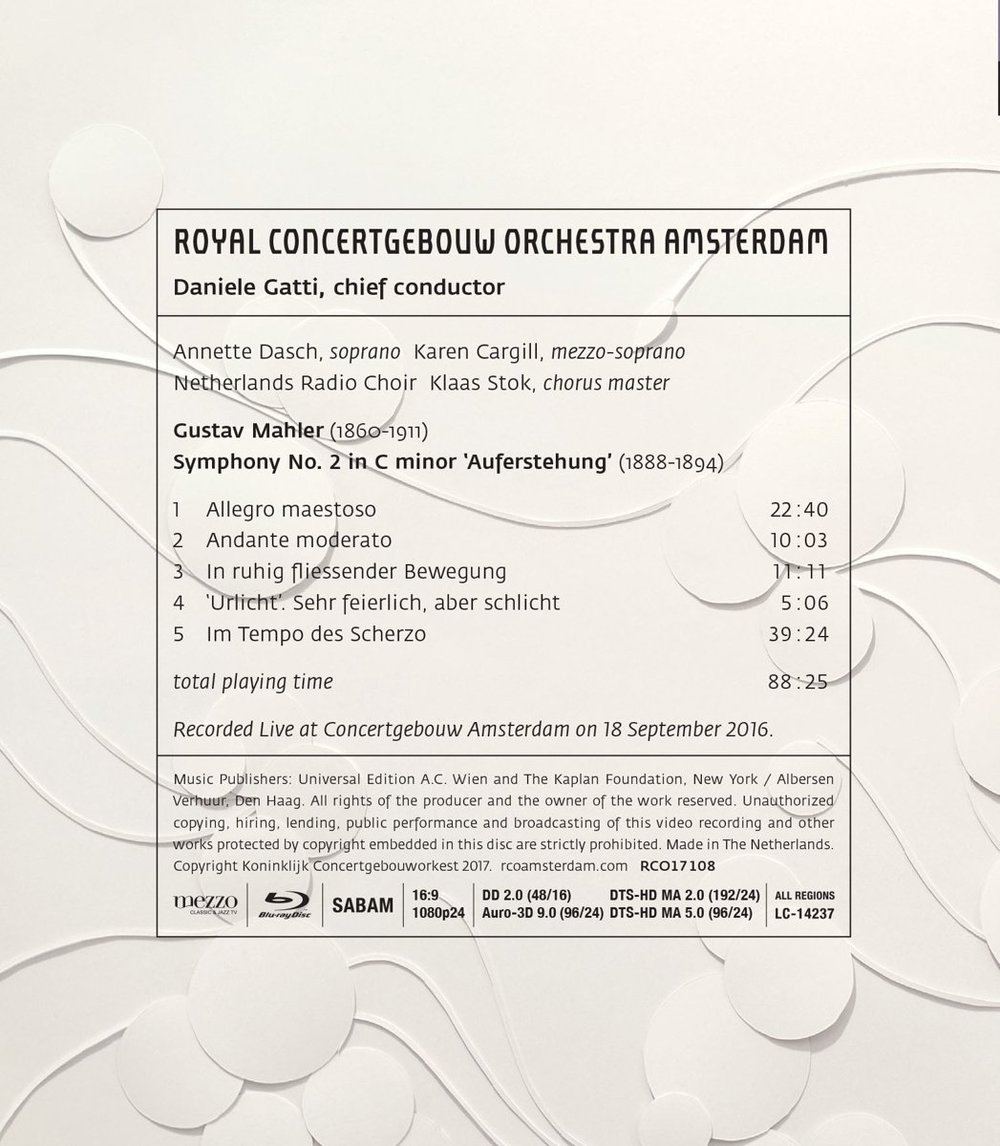

Mahler Symphony No. 2 ("Resurrection"). In 2016 Daniele Gatti conducts the Royal Concertgebouw Orchestra & Netherlands Radio Choir at the Concertgebouw Amsterdam (Chorus Master Klaas Stok). Singers are Anette Dasch (soprano) and Karen Cargill (mezzo-soprano). Directed for TV by Dick Kuijs. Released 2017, the music reviewed here was recorded with 96kHz/48-bit sound sampling and played with a 5.0 dts-HD Master Audio file. The disc also has a stereo sound file recorded at 192/24 and a 9.0 Auro-3D file (a first for us). Grade: B+
RCO Live, the in-house publishing arm of the Royal Concertgebouw Orchestra, publishes here their second Blu-ray recording of Mahler Symphony 2. The first was part of their 2012 10-symphony Mahler box-set and was also sold separately from 2012 on as Music Is the Language of the Heart and Soul: A Portrait of Mariss Jansons and Mahler Symphony No. 2. We graded down the first attempt severely for surprisingly poor video content. In 2012, RCO Live had had years to perfect the miking and sound editing used in their CD recordings. Blu-ray video was still a new endeavor for the company, so problems might have been expected. Well, 5 years have passed since 2012, and we had hoped that RCO Live would have learned to make Blu-ray video as good as their sound recordings. However this is has not proven to be the case—once again we have an RCO Live Blu-ray that is excellent to listen to, but disappointing to look at. Even so, we ended up with a pretty good grade for this recording, so let's now consider why.
First, the main positives. The RCO is considered by many to be the best orchestra in the world. The performance here is the strongest case we have yet come across to support that claim. The RCO musicians play together with almost scary intensity and accuracy. In other recordings (even with top orchestras), Mahler's complicated structures can seem muddled at times. But this doesn't happen with the RCO and Gatti.
Gatti follows Mahler's instruction to play this music slowly enough to allow all the notes to be heard. This recording is the longest of the 7 Mahler Symphony 2 recordings in our library on Blu-ray (4 minutes longer than the shortest version [Boulez]). Gatti also makes the most of the fermatas (optional pauses) throughout the score to add drama. The sound engineering is world-class with awesome fidelity and brilliant miking and mixing in the orchestra's home hall. It seems you can always hear everything, and this is especially noticeable during Mahler's many pizzicato segments, which are hard to record.
Another positive is that the video content in 2016 is much improved over 2012 (more on this later). Finally, this piece has a quite a bit of off-stage music for mystical effect, and this is pretty-well indicated by the video, at least for viewers who know about this.
Now to the main negative. A shocking defect in this recording is poor PQ that is a step backwards from the 2012 recording of M2! This step backward results from severely cutting back on the amount of light put on the stage for the 2016 recording. The next shot below is a typical view of the whole orchestra in 2016—note how gloomy it is:
And next below is a 2016 shot showing more of the hall (this shot was used to indicate off-stage music being played). Note there is only a single row of lights hanging from the ceiling to illuminate the stage (ignore the ceiling lights in the foreground that are used to illuminate the seating area for the convenience of the audience):
Now let's contrast the 2012 lighting to what we find in the 2016 record. The first view next below is from 2012. It's bright with light. Note the multitude of light fixtures hanging from the ceiling that shine on the stage and even block our view of the organ from this perspective. Then look at the next and darker view below from 2016. There are far fewer lights, the stage is darker, and we now have a clear view of the organ. It seems obvious the reduction of light is the source of the problem with PQ in 2016. The video team doubtless had modern gear. It appears they were expected to get good PQ even with less light by tweaking the cameras, or maybe the tweaking was done in post-production. But the tweaking failed and generally gives us a dank, oppressive PQ.
2012 PQ
2016 PQ
It also appears that a by-product of the image tweaking was creation of unpleasant artifacts in PQ. In 2016, objects on the stage that reflect a lot of light seem to generate a glare of their own. This includes the white sheet music, Gatti's white vest, shiny brass instruments, and even the tops of the heads of several bald musicians. For example, next below you see an image of 8 horns from the 2016 performance. The upper right horn has a dull finish and looks OK. But the images of the other shiny horns are broken up by glare:
Compare the horns above to a similar shot of horns below from 2012. In 2012 the horns looked fine even though the light on the stage was much brighter:
Why did the RCO reduce the lights? Maybe they hoped to cool down the stage to make the musicians and the conductor more comfortable. Next below is a picture of Jansons in 2012 close to the end of the symphony. It's a little hard to see in a still picture, but his hair and face are drenched in sweat. (Gatti in 2016 seems to stay cool the whole time.)
Next below is a whole-orchestra shot from subject title. Note the darkness of the scene overall and the glowing sheet music. All this is unpleasant to watch:
And now we come to our last screenshot dealing with illumination. Enjoy this view of the RCO hall made in 2009 in the good-old days when Haitink conducted Bruckner Symphony No. 9:
Next below is a nice WO shot:
And here is a view of some off-stage performers:
The near-shots and close-ups in this video have a lot of shadows, but they still look pretty good:
A rare view of violas:
Here's the percussion working on that huge crescendo in the 5th Movement:
And here's that wonderful brass choir from Movement 5:
A great shot of a great double-bass section:
In the next shot below, off-stage horns arrive to give a total of 10 horns at the end. Neither of the soloists exhibited great German diction (Dasch on the left is native German). This title does not have subtitles for the text sung by the soloists or the chorus. The sung text is, however, printed in the keepcase booklet in German and in several European languages. If you are familiar with this music, you can probably follow the singing from the text provided. (If you want to have subtitles in English or German, try Music Is the Language of the Heart and Soul: A Portrait of Mariss Jansons and Mahler Symphony No. 2, but then you will have to put up with bad video content.)
A good multi-section shot:
All the violins:
Finally, a couple of low-value shots with framing errors. The RCO should not tolerate shots like this:
We graded the 2012 Mahler S2 from the RCO box set down to a D+ because of dreadful video content and lack of subtitles. But in 2016, the RCO made huge steps forward in this regard. I ran a Wonk Worksheet on the 2016 video.
There are 88 minutes of music divided into 594 video clips. This yields the pace of 8.9 seconds per clip for the whole symphony.
Here's the clip breakdown:
Conductor shots = 70
Conductor-over-backs shots = 3
Soloist not realistic =4
*Soloist realistic = 13
Solo and other small-scale clips = 293
*Large-scale clips = 127
*Part-orchestra clips = 19
*Whole-orchestra clips = 40
Instrument-only clips = 3
Other low-value shots = 9
*Other high value=12
There are 211 "supershots" (add up the * numbers above of 13+127+19+40+12). So the supershots are 35% of the total clips (211/594). Conductor shots total 73 (70+3), and conductor shots use up 13% of the clips (73/594). 76% of the soloist shots are "realistic."
HDVDarts.com has established the following rules-of-thumb to identify a Blu-ray with DVDitis:
“A good symphony HDVD should have a slow pace with more than 10 seconds per video clip on average. 20 to 40% of the clips should be large-scale "supershots." Conductor shots should be less (way less really) than 20% of the clips in the video.”
Subject title fails the pace test with the average clip running less than 10 seconds, but the pace of 8.9 seconds is close. And if you will check my numbers for Movement 5 (which is roughly 1/2 of the whole symphony), you will see that the pace for Movement 5 is 11.4 seconds per clip, which passes. All the other tests are passed convincingly. So I will not diagnose DVDitis in this patient, and that's pretty rare these days with our symphony HDVDs!
Now to a grade. We start with A+, and there is no deduction for SQ. We reduce a full grade for the poor PQ to B+. I reduce to C+ for lack of subtitles and weak diction by singers. But I add a full grade for strong performance and excellent recording technique to arrive a B+. Too bad—with better lighting and nice subtitles, this could have been an A or A+ title.
OR






















